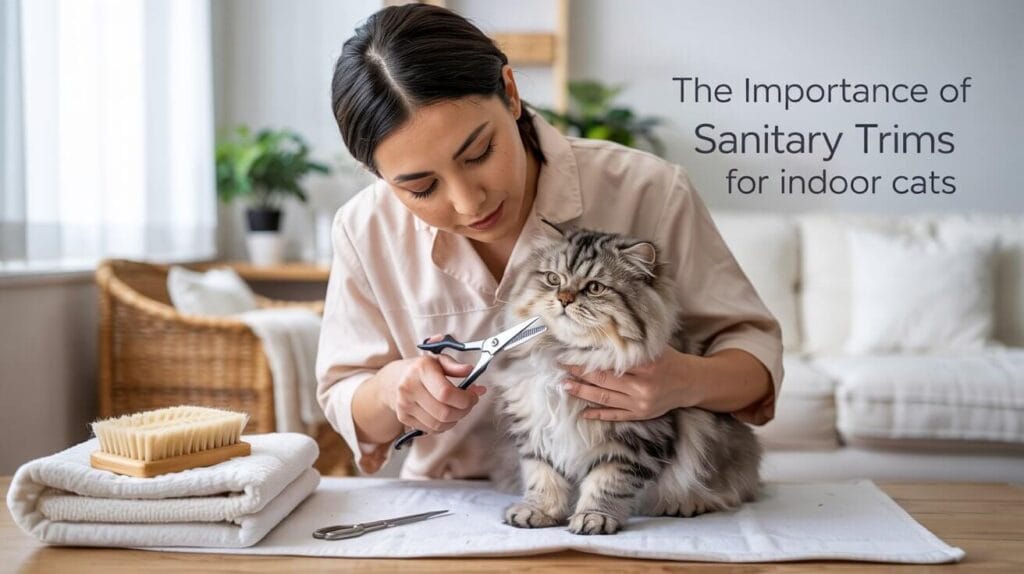Many cat owners believe that since their feline companions are fastidious groomers, they don’t need professional grooming. While cats do a great job of cleaning themselves, certain grooming needs—like sanitary trims—are best left to professionals. For indoor cats, sanitary trims are more than just an aesthetic choice; they play a critical role in overall health and hygiene.
In this article, we’ll explore why sanitary trims are essential, especially for indoor cats, how often they should be done, and the potential problems they help prevent.
What Is a Sanitary Trim?
A sanitary trim refers to the trimming or shaving of the fur around your cat’s rear end, inner thighs, and genital area. This grooming practice is especially beneficial for long-haired breeds and older cats that may have trouble cleaning themselves effectively. Sanitary trims help reduce the accumulation of fecal matter, urine, and other debris in sensitive areas.
Why Sanitary Trims Are Essential for Indoor Cats
1. Improved Hygiene
Even the most meticulous indoor cat can struggle with cleaning certain areas. Sanitary trims ensure that their private areas remain free of fecal debris and urine clumps, reducing odors and keeping their environment cleaner.
2. Prevention of Matting and Tangles
Fur in the genital and anal regions can become tangled and matted, especially in long-haired cats. Mats can pull on the skin, cause discomfort, and create breeding grounds for bacteria. Sanitary trims prevent this buildup.
3. Reducing Urinary Tract Infections (UTIs)
Trapped urine in the fur can increase the risk of bacterial infections and UTIs. Trimming the fur in these areas reduces the likelihood of bacteria harboring close to the urethra.
4. Minimizing Hairballs
Cats ingest less hair from those hard-to-reach areas when they are trimmed. This can decrease the frequency of hairballs, a common issue among indoor cats.
5. Comfort for Aging or Overweight Cats
Older cats or those with limited mobility often can’t clean themselves thoroughly. A sanitary trim ensures their hygiene without relying solely on their ability to self-groom.

Breeds That Especially Benefit from Sanitary Trims
While all indoor cats can benefit from sanitary trims, some breeds are more prone to needing them:
- Persians
- Himalayans
- Maine Coons
- Ragdolls
- British Longhairs
These breeds often have long or dense fur that is prone to matting and requires regular grooming, including trims around sensitive areas.
Top Cat Breeds That Require Regular Grooming
Signs Your Cat May Need a Sanitary Trim
You don’t have to wait for a mess to act. Here are some signs that indicate your cat might benefit from a sanitary trim:
- Clumps of fecal matter around the rear
- Urine odor coming from the cat
- Frequent scooting or excessive licking
- Visible mats near the tail or inner thighs
- Litter tracking more than usual
Our Pet Grooming Services in Different Areas:
- Mobile Cat Grooming Orlando
- Mobile Dog Grooming Orlando
- Mobile Pet Grooming Apopka FL
- Mobile Pet Grooming in Kissimmee FL
- Mobile Pet Grooming Winter Park FL
- Mobile pet grooming Orlando
- Mobile Pet Grooming in Sanford FL
- Mobile Pet Grooming in Oviedo, FL
- Mobile Pet Grooming in Lake Mary, FL
- Mobile Pet Grooming in Maitland, FL
- Mobile Pet Grooming in Lake Nona, FL
- Mobile Pet Grooming in Baldwin Park, FL
How Often Should You Schedule a Sanitary Trim?
The frequency depends on your cat’s coat type, lifestyle, and grooming habits. As a general guideline:
- Long-haired breeds: Every 4 to 6 weeks
- Short-haired breeds: Every 6 to 8 weeks
- Senior or obese cats: Monthly or as needed
Scheduling regular trims prevents hygiene issues before they begin, rather than addressing them reactively.
DIY vs. Professional Grooming
While some pet owners may attempt a sanitary trim at home, it requires extreme care. Sensitive areas can be easily nicked or irritated without the right tools and experience. Professional groomers are trained to handle pets safely and hygienically, using clippers specifically designed for delicate grooming tasks.
Benefits of professional sanitary trims include:
- Safe handling of sensitive areas
- Reduced stress for the cat
- Clean and even trims
- Early detection of skin issues, rashes, or parasites
Additional Grooming Tips for Indoor Cats
Sanitary trims are just one part of a comprehensive grooming routine. To maintain your cat’s overall health and comfort:
- Brush regularly: Reduce shedding and matting
- Clean eyes and ears: Especially for breeds prone to discharge
- Trim nails: Prevent scratching and injury
- Monitor coat and skin health: Look for signs of dryness or parasites
Health Conditions Sanitary Trims Can Help Prevent
Regular sanitary trims contribute to the early detection and prevention of several health issues, such as:
- Dermatitis and skin infections
- Anal gland issues
- Fungal infections
- Parasite infestations
- Obstructed bowel movements due to fur matting
Cats that are groomed regularly tend to have healthier skin and coats and are less likely to develop conditions caused by poor hygiene.
Conclusion
Sanitary trims are not a luxury—they’re a necessity for many indoor cats. They contribute significantly to your cat’s health, hygiene, and overall comfort. Regular trims reduce the risk of infections, matting, and discomfort while also making it easier for you to maintain a clean home.
Whether you have a long-haired Persian or a short-haired domestic, scheduling regular sanitary trims with a professional groomer can go a long way in ensuring your feline companion stays healthy and happy.
By prioritizing regular grooming—including sanitary trims—you’re giving your cat the quality of care they truly deserve.

